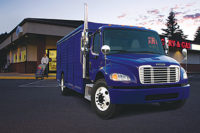It is about that time of year again: time to start thinking about — and preparing for — deer-vehicle collision (DVC) season, or as some refer to it, deer-vehicle accident (DVA) season. I never really gave DVCs much thought until a recent incident brought the issue up close and personal.
I was driving home alone from the airport very late one night along a familiar rural two-lane road when I almost became a DVC statistic. All of a sudden, a large deer bounded onto the road from a corn field on my right and froze. I immediately slowed down and hit the horn, but the deer stayed put.
Realizing I wasn’t going to be able to stop in time, some advice I received from a veteran trucker when I first got into trucking many years ago popped into my mind. He had instructed me never to swerve to miss hitting a deer.
“Reduce speed, brake and keep a straight course,” he advised. “The deer will usually run off, but you won’t know which way.”
Once you swerve, you are at a much greater risk of hitting oncoming traffic, a tree, a light post, a mailbox or some other stationary object, he said.
Although difficult to do — because swerving to avoid any animal in the road is a natural reaction — I continued straight ahead, mentally guessing the deer would run back the way it had come. Although I reckoned wrong and the deer ran across the road, thankfully my first deer-vehicle encounter ended safely.
Significant safety issue
Studies by the Insurance Institute for Highway Safety (IIHS) show that three out of four vehicle-animal collisions involve deer. Ninety percent of these collisions are fatal to the deer, research finds. Sixty-five percent cause injury to humans.
IIHS estimates that approximately 1.6 million DVCs occur annually in the United States, causing about 200 fatalities, tens of thousands of injuries and more than $3.6 billion in vehicle damage. That does not include the costs of unscheduled vehicle downtime and loss of fleet and shop productivity.
According to claims data from insurance company State Farm, the top states for DVCs are as follows: West Virginia, where there is a 1 in 53 chance a driver will hit a deer, Iowa (1 in 77), South Dakota (1 in 81), Pennsylvania (1 in 86), and Michigan (1 in 90), followed by Montana, Wisconsin, Minnesota, North Dakota and Wyoming. The state in which DVCs are least likely is Hawaii, where the chance that a driver will hit a deer is 1 in 6,267.
The majority of DVCs occur between the months of October and December when deer are most active due to migration and mating. More accidents occur during the night, or anytime between dusk and dawn, because deer are nocturnal animals and spend most of their time foraging during these periods.
Driver reaction
Safety officials say the most effective way to avoid DVCs is through attentive driving behavior. They note that driver reaction usually dictates the severity of such accidents. Safety officials recommend a number of precautions to keep drivers safe and minimize the chances of colliding with a deer when driving, including the following:
• Heed deer crossing signs. Decrease speed in these areas and drive with extra caution. The sooner a deer is seen on or approaching a roadway, the better the chance of avoiding a crash.
• Be especially attentive in areas near woods, farmlands, water and areas known to have a large deer population. When driving through these areas, keep eyes moving, continually glancing to both sides of the road.
• Do not rely on devices such as deer whistles, deer fences and reflectors to deter deer because these devices have not proven to be effective.
• At night, use high-beam headlights to better illuminate the edges of the road where deer might linger. Look for the reflection of light in a deer’s eyes. If you see eyes reflected in your headlights, slow down immediately.
• Headlights tend to hypnotize deer when a vehicle approaches. If a deer is spotted, be alert, slow down quickly and sound the horn to try to scare it away.
• Keep in mind that if one deer is spotted, more are usually nearby. Deer often travel in groups and in a single-file line.
• Deer are unpredictable in their movements, especially when confronted with glaring headlights, blaring horns and moving vehicles. Do not presume to know which way a deer will move.
• If a collision with a deer seems inevitable, brake firmly and attempt to stop. Do not swerve to avoid the deer because vehicle control can be lost, increasing the risk of injury due to hitting another vehicle or a fixed object like a tree.
• If a deer is struck, stay away from it. It may just be stunned and could become very aggressive. A frightened and wounded deer can hurt you or further injure itself. Report the accident to the local Game Commission or law enforcement. BI


